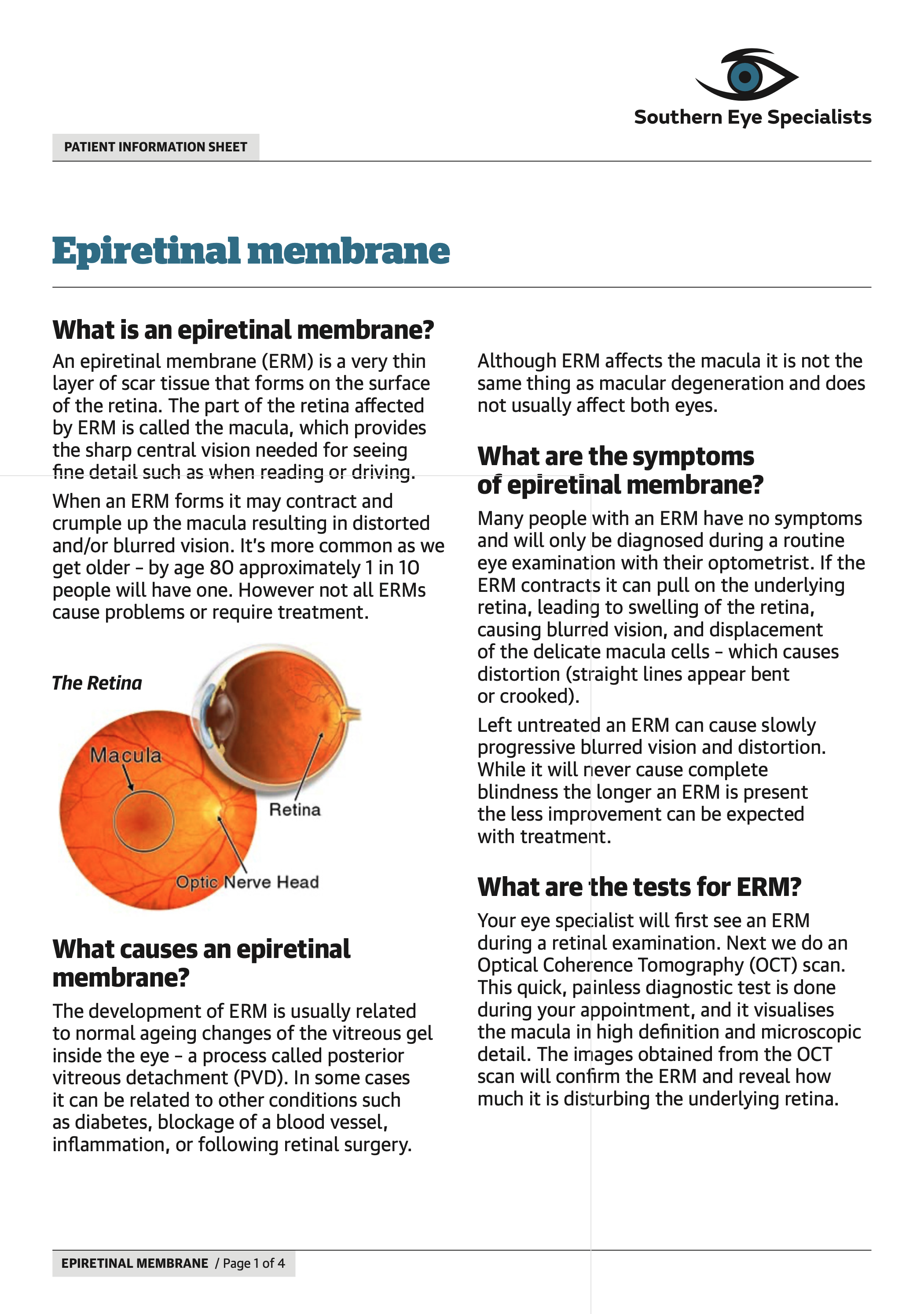Eye Conditions
Epiretinal Membrane
An epiretinal membrane affects the sharp, central vision required for tasks such as reading and driving. Not all cases require surgery but if quality of life is affected, surgery is needed to remove the membrane and improve vision.
In the eye the macula is the small part of the retina responsible for producing clear and detailed vision. An epiretinal membrane is a thin, transparent layer of tissue that grows over the surface of the retina, causing blurry and distorted central vision. Straight lines will appear curved or kinked.
The symptoms of epiretinal membrane vary greatly from patient to patient and can affect one or both eyes. For some patients, symptoms are almost negligible. For others serious reduced vision and problematic distortion can occur as the membrane shrinks and contracts.
Epiretinal membranes are typically caused by age-related changes in the vitreous gel of the eye. Other less common causes include inflammation within the eye (uveitis), previous eye surgery, retinal tears or a blocked retinal blood vessel. The condition is commonly found in patients 60 years and over.
Southern Eye Specialists offers the most advanced equipment currently available to detect and diagnose epiretinal membrane. A special eye scan, called Optical Coherence Tomography (OCT), generates a highly magnified cross-section image of the macula, allowing our team to view the most microscopic details of the epiretinal membrane. This scan provides both greater accuracy in diagnosis and more effective treatment.
Condition
An epiretinal membrane can cause blurred central vision or distorted vision.
Treatment
Treatment starts with a detailed eye scan, which provides a cross-section of the macula to detect epiretinal membrane.
Care
Eye drops, medicines and laser will not improve blurred vision or distortion caused by epiretinal membranes.
FAQ’s
How is epiretinal membrane treated?
Not all cases of epiretinal membranes will require surgery. Treatment can range from no action at all (apart from close monitoring) to eye surgery. Vitrectomy surgery will be recommended for patients who experience blurry vision or vision distortion that might affect their daily activities and quality of life.
How can you test for epiretinal membrane?
At Southern Eye Specialists we take an eye scan using an Optical Coherence Tomography machine, which generates a cross-section image of the retina and epiretinal membrane. This confirms the diagnosis and helps your eye specialist determine the severity of the epiretinal membrane and best treatment option.
Why does epiretinal membrane occur?
The condition can affect up to 10 per cent of the population aged 60 years and over. While epiretinal membrane is most commonly linked with natural aging changes in the vitreous gel it can also be related to inflammation, previous eye surgery, retinal tears or blockage of the blood vessels.
What is vitrectomy?
Vitrectomy surgery is the procedure used to remove the epiretinal membrane. The procedure is usually highly successful in improving vision and reducing distortion. The surgery involves making keyhole incisions in the white of the eye, removing the vitreous and then peeling the epiretinal membrane off the retina with forceps. Vitrectomy is typically performed under local anaesthetic as a day surgery. The surgery will be performed by your eye specialist in an operating theatre at a dedicated eye care facility.
How does an epiretinal membrane affect vision?
The small part of the retain called the macula is a delicate and intricate part of the eye, composed of 10 layers that are all inter-connected and precisely located. Epiretinal membranes consist of scar-forming tissue which can contract, similar to the process the occurs in a skin scar. As the epiretinal membrane contracts it causes the delicate macula to become swollen. This leads to blurred vision and, as the membrane pulls the layers of the macula out of place, vision distortion.
